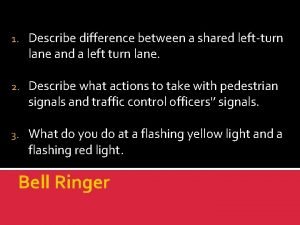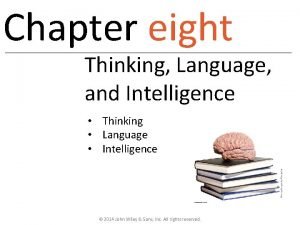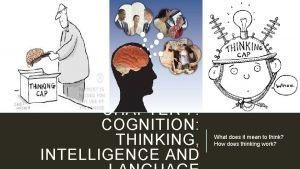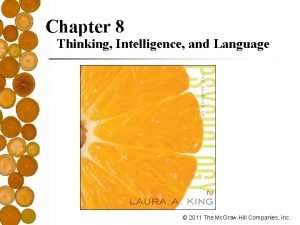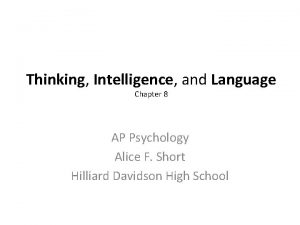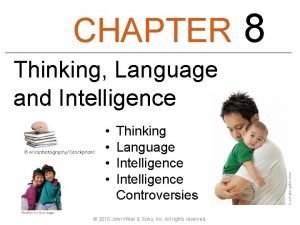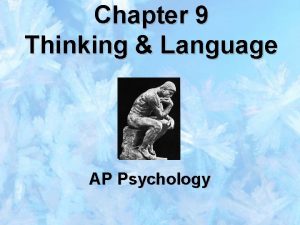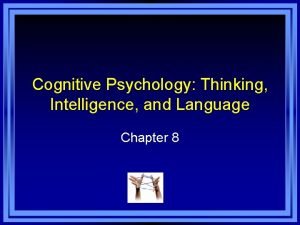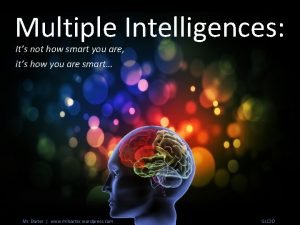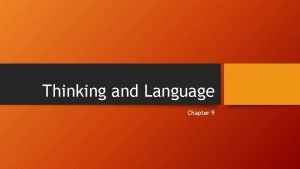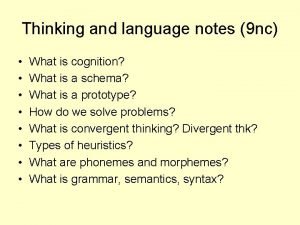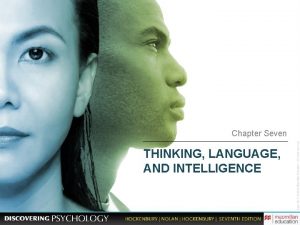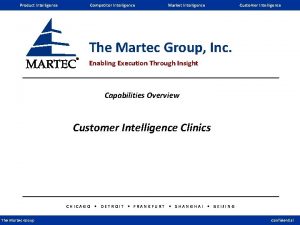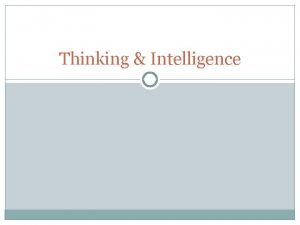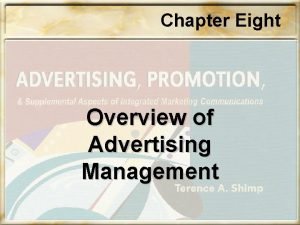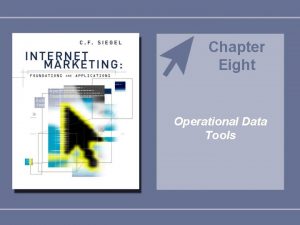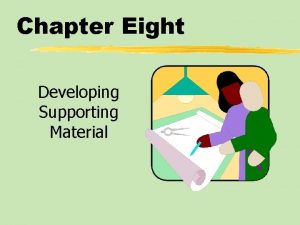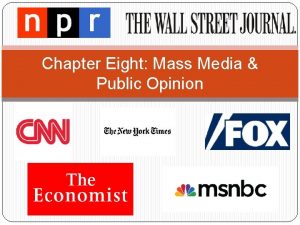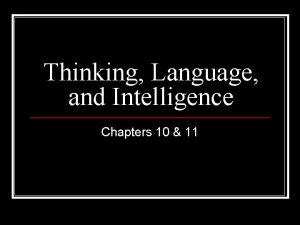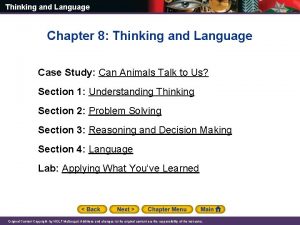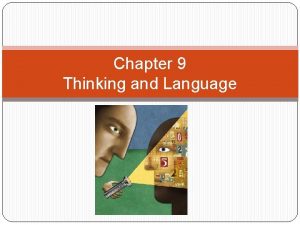Chapter eight Thinking Language and Intelligence Thinking Language




















- Slides: 20

Chapter eight Thinking, Language, and Intelligence • Thinking • Language • Intelligence © 2014 John Wiley & Sons, Inc. All rights reserved.

realworldpsychology Things You’ll Learn in Chapter 8 Q 1 Why might some medical treatments be judged as more effective than they really are? Q 2 Can studying in a coffee shop improve your creativity? Q 3 Can babies begin to learn language even before they are born? Q 4 Do bigger brains indicate greater intelligence? Q 5 Does caregiving in the first years of life have a lasting impact on brain size and development? © 2014 John Wiley & Sons, Inc. All rights reserved.

Cognition • Cognition = the mental activities involved in acquiring, storing, retrieving, and using knowledge • Thinking is both localized and distributed throughout the brain in networks of neurons © 2014 John Wiley & Sons, Inc. All rights reserved.

Cognitive Building Blocks • Imagine yourself at the beach. What do you see? Smell? Hear? Feel? • Mental image = the mental representation of a previously stored sensory experience, including visual, auditory, olfactory, tactile, motor, or gustatory imagery © 2014 John Wiley & Sons, Inc. All rights reserved.

Cognitive Building Blocks • Concept = the mental representation of a group or category • Concepts developed through 3 building blocks 1. Prototype = the example that embodies the “best” or most typical feature of a concept Think of a bird…. . © 2014 John Wiley & Sons, Inc. All rights reserved.

Cognitive Building Blocks 2. Artificial (formal) concept = a clearly defined concept based on a set of logical rules, also known as a formal concept Did anyone think of a penguin? When something doesn’t fit the prototype, must review artificial concept © 2014 John Wiley & Sons, Inc. All rights reserved.

Cognitive Building Blocks When something doesn’t fit the prototype, must review artificial concept – Formal concept of a bird: warm blooded, has wings and a beak, flies, and lays eggs – Penguins don’t fly – but have all the other characteristics – so we need to be flexible © 2014 John Wiley & Sons, Inc. All rights reserved.

Cognitive Building Blocks 3. Hierarchies = subcategories within broader concepts • We learn basic-level before higher- and lowerorder © 2014 John Wiley & Sons, Inc. All rights reserved.

Solving Problems • Solving problems means moving from the given state (problem) to a goal state (solution) • Three steps: 1. Preparation – define goal, outline limits 2. Production – test possible options using • Algorithms: logical, step-by-step procedure that will always eventually solve the problem • Heuristics: cognitive strategy or “rule of thumb” used as a shortcut for problem solving; does not guarantee a solution but does narrow down alternatives 3. Evaluation – determine if solution solves problem © 2014 John Wiley & Sons, Inc. All rights reserved.

Solving Problems • In what section of the grocery store can you find sun-dried tomatoes? • How could you find them? – Algorithm – walk each isle until you find them – Heuristic – guess which section they might be in (Fresh produce? Canned vegetables? ) © 2014 John Wiley & Sons, Inc. All rights reserved.

Who is Thomas? Indiana Trucker Indiana Jones

Who Is Thomas © 2014 John Wiley & Sons, Inc. All rights reserved.

Barriers to Problem Solving Improper use of heuristics • Availability heuristic = a cognitive strategy (shortcut) that involves making judgments based on information that is readily available in memory • Representativeness heuristic = a cognitive strategy (shortcut) that involves making judgments based on how well an object or event matches (represents) an existing prototype in our minds © 2014 John Wiley & Sons, Inc. All rights reserved.

Barriers to Problem Solving • Confirmation Bias = the bias of preferring information that confirms preexisting positions or beliefs, while ignoring or discounting contradictory evidence Q 1 Why might some medical treatments be judged as more effective than they really are? Treatment outcomes in medical research studies were judged to be more positive when the evaluator knew what treatment each patient received (not blind to condition). © 2014 John Wiley & Sons, Inc. All rights reserved. How might this affect a doctor’s treatment decisions?

realworldpsychology • Ever heard of the Sports Illustrated “cover jinx”? • That’s confirmation bias! © 2014 John Wiley & Sons, Inc. All rights reserved.

Barriers to Problem Solving • Sometimes we struggle to solve problems because: • Mental set = a problem-solving strategy that has worked in the past, which we continue to use rather than trying new strategies • Functional fixedness = the inability to think of an object functioning only in its usual or customary way; adversely affects problem solving and creativity Tutorial Video: Barriers to Problem Solving © 2014 John Wiley & Sons, Inc. All rights reserved.

The Dot Problem Can you draw four straight lines so that they pass through all nine dots without lifting your pencil from the page and without touching any dot more than once? © 2014 John Wiley & Sons, Inc. All rights reserved.

© 2014 John Wiley & Sons, Inc. All rights reserved.

Creativity • Creativity = the ability to produce original, appropriate, and valued outcomes in a novel way • Has three characteristics: Video: Bird Brain Gene © 2014 John Wiley & Sons, Inc. All rights reserved.

Creative Thinking • Divergent thinking = an aspect of creativity characterized by an ability to produce unusual but appropriate alternatives from a single starting point © 2014 John Wiley & Sons, Inc. All rights reserved.
 Plane figures
Plane figures A short section of corrugated roadway that warns of hazards
A short section of corrugated roadway that warns of hazards Chapter 8: thinking, language, and intelligence
Chapter 8: thinking, language, and intelligence Chapter 7 cognition thinking intelligence and language
Chapter 7 cognition thinking intelligence and language Cognition thinking intelligence and language
Cognition thinking intelligence and language Chapter 8 thinking language and intelligence
Chapter 8 thinking language and intelligence Is evaluating alternatives and making choices among them.
Is evaluating alternatives and making choices among them. When you group subcategories within broader concepts
When you group subcategories within broader concepts Belief perseverance
Belief perseverance Thinking language and intelligence
Thinking language and intelligence Thinking intelligence and language
Thinking intelligence and language It's not how smart you are it's how you are smart
It's not how smart you are it's how you are smart Language
Language Airline reservations typically decline after
Airline reservations typically decline after Chapter 8 great gatsby summary
Chapter 8 great gatsby summary Lord of the flies chapter 8 short summary
Lord of the flies chapter 8 short summary Positive thinking vs negative thinking examples
Positive thinking vs negative thinking examples Thinking about your own thinking
Thinking about your own thinking Holistic judgement
Holistic judgement Perbedaan critical thinking dan creative thinking
Perbedaan critical thinking dan creative thinking Thinking about you thinking about me
Thinking about you thinking about me

